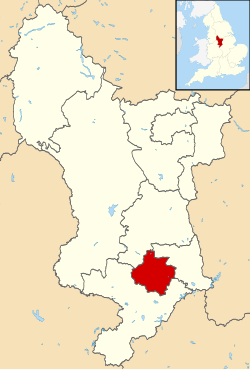
Back Derby (Derbyshire) ALS ደርቢ Amharic Derby AN Dēorabȳ ANG دربي (إنجلترا) Arabic ديربى ARZ Derby AST Derbi Azerbaijani داربی، اینگیلیس AZB Дэрбі (Англія) Byelorussian
Derby (/ˈdɑːrbi/ ⓘ DAR-bee) is a city and unitary authority area on the River Derwent in Derbyshire, England. Derbyshire is named after Derby, which was its original county town. As a unitary authority, Derby is administratively independent from Derbyshire County Council. The population of Derby is 263,490 (2022).[4]
The Romans established the town of Derventio, which was later captured by the Anglo-Saxons and then by the Vikings who made Djúra-bý one of the Five Boroughs of the Danelaw. Initially a market town, Derby grew rapidly in the industrial era and was home to Lombe's Mill, an early British factory and it contains the southern part of the Derwent Valley Mills World Heritage Site. With the arrival of the railways in the 19th century, Derby became a centre of the British rail industry. Despite having a cathedral since 1927, Derby did not gain city status until 1977.
Derby is a centre for advanced transport manufacturing. It is home to engine manufacturer Rolls-Royce and Alstom (formerly Bombardier Transportation) has a production facility at the Derby Litchurch Lane Works; Toyota's UK headquarters is located in the south-west of the city at Burnaston.
- ^ a b "Derby, City of Derby". Ordnance Survey. Retrieved 16 January 2024.
- ^ "Leadership of the Council". Derby City Council. Retrieved 12 November 2023.
- ^ "Mid-Year Population Estimates, UK, June 2022". Office for National Statistics. 26 March 2024. Retrieved 3 May 2024.
- ^ a b "Mid-Year Population Estimates, UK, June 2022". Office for National Statistics. 26 March 2024. Retrieved 3 May 2024.
- ^ a b UK Census (2021). "2021 Census Area Profile – Derby Local Authority (E06000015)". Nomis. Office for National Statistics. Retrieved 12 November 2023.
- ^ a b Fenton, Trevor (25 April 2023). "Regional gross domestic product: local authorities". Office for National Statistics. Retrieved 2 March 2024.






